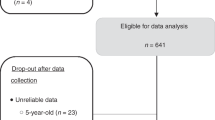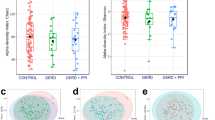Abstract
Background/Objectives:
It is unknown what causes uraemic symptoms in renal disease. Chronic kidney disease (CKD) patients are known to have increased levels of urea, sodium, potassium and phosphate in their saliva compared with those without renal disease. The present cross-sectional study investigated associations between known genetic traits of taste and self-reported upper gastrointestinal (GI) symptoms experienced in CKD patients with the changes in saliva composition found in renal failure.
Subjects/Methods:
Fifty-six CKD patients (35 males, 21 females, age 67±14 years), with stages 4 and 5 renal failure, selected from a tertiary hospital renal outpatient clinic participated in this study. Subjects answered a questionnaire to assess upper GI symptoms and tested for the genetic taste recognition thresholds of thiourea, phenylthiocarbamide and sodium benzoate. Saliva samples were collected to determine biochemical composition. Possible associations between genetic taste variations, saliva composition and upper GI symptoms were investigated.
Results:
Of the 56 patients enroled, 29 (52%) reported major upper GI uraemic symptoms, whereas 27 (48%) had no symptoms or only minor complaints of dry mouth. There was a strong association between the symptomatic burden a patient experienced and the genetic ability to taste thiourea (P<0.0003). Uraemic symptoms of taste changes (P<0.004) and nausea (P<0.002) were found to be related to a patient’s genetic ability to taste thiourea.
Conclusions:
This study provides evidence that the genetic ability to taste thiourea as bitter, in combination with the increase in active compounds found in CKD patient’s saliva, impacts on the uraemic upper GI symptoms experienced.
This is a preview of subscription content, access via your institution
Access options
Subscribe to this journal
Receive 12 print issues and online access
$259.00 per year
only $21.58 per issue
Buy this article
- Purchase on Springer Link
- Instant access to full article PDF
Prices may be subject to local taxes which are calculated during checkout


Similar content being viewed by others
References
Carrero JJ, Stenvinkel P, Cuppari L, Ikizler TA, Kalantar-Zadeh K, Kaysen G et al. Etiology of the protein-energy wasting syndrome in chronic kidney disease: A joint statement from the International Society of Renal Nutrition and Metabolism (ISRNM). J Ren Nutr 2013; 23: 77–90.
Caravaca F, Arrobas M, Pizarro J, Sanchez-Casado E . Uraemic symptoms, nutritional status and renal function in pre-dialysis end-stage renal failure patients. Nephrol Dial Transplant 2001; 16: 776–782.
Carrero JJ . Mechanisms of altered regulation of food intake in chronic kidney disease. J Ren Nutr 2011; 21: 7–11.
Manley KJ . Saliva composition and upper gastrointestinal symptoms in chronic kidney disease. J Ren Care 2014; 40: 172–179.
Tomás I, Marinhob JS, Limeresa J, Santosc MJ, Araújod L, Diza P . Changes in salivary composition in patients with renal failure. Arch of Oral Biol 2008; 53: 528–532.
Kho HS, Lee SW, Chung SC, Kim YK . Oral manifestations and salivary flow rate, pH, and buffer capacity in patients with end-stage renal disease undergoing hemodialysis. Oral Surg Oral Med Oral Pathol Oral Radiol Endod 1999; 88: 316–319.
Bots C, Brand H, Veerman E, Valentijn-Benz M, Henskens YM, Valentijn RM et al. Acute effects of hemodialysis on salivary flow rate and composition. Clin Nephrol 2007; 67: 25–31.
Manley KJ, Haryono R, Keast RSJ . Taste changes and saliva composition in chronic kidney disease. Ren Soc Australas J 2012; 8: 56–60.
Savica V, Calo LA, Santoro D . Salivary glands: a new player in phosphorus metabolism. J Ren Nutr 2011; 21: 39–42.
Bartoshuk LM . Psychophysical advances aid the study of genetic variation in taste. Appetite 2000; 34: 105.
Aniliker JA, Bartoshuk I, Ferris AM, Hooks LD . Children's food preferences and genetic sensitivity to the bitter taste of 6-n-propylthiouracil (PROP). Am J Clin Nutr 1991; 54: 316–320.
Harris H, Kalmus H . The measurements of taste sensitivitiy to phenylthiourea (P.T.C.). Ann Eugen 1949; 15: 24–30.
Smutzer G, Desai H, Coldwell SE, Griffith JW . Validation of edible taste strips for assessing PROP taste perception. ChemSenses 2013; 38: 529–539.
Tepper BJ . 6-n-Propylthiouracil: a genetic marker for taste, with implications for food preference and dietary habits. Am J Hum Genet 1998; 63: 1271–1276.
Michon C, O'Sullivan MG, Delahunty CM, Kerry JP . The investigation of gender-related sensitivity differences in food perception. J Sens Stud 2009; 24: 922–927.
Boltong A, Campbell K . Taste changes: a problem for patients and their dietitians. Nutr Diet 2013; 70: 262–269.
Delwiche JF, Buletic Z, Breslin PA . Covariation in individuals' sensitivities to bitter compounds: evidence supporting multiple receptor/transduction mechanisms. Percept Psychophys 2001; 63: 761–776.
Kim UK, Drayna D . Genetics of individual differences in bitter taste perception: lessons from the PTC gene. Clin Genet 2004; 67: 275–280.
Harris H, Kalmus H . Genetical differences in taste sensitivity to phenylthiourea and to anti-thyroid substances. Nature 1949; 163: 878.
Drewnowski A, Rock C . The influence of genetic taste markers on food acceptance. Am J Clin Nutr 1995; 62: 505–5011.
Williams RJ . Taste deficiency for creatine. Science 1931; 74: 597–598.
Middleton RA, Allman-Farinelli MA . Taste sensitivity is altered in patients with chronic renal failure receiving continuous ambulatory peritoneal dialysis. J Nutr 1999; 129: 122–125.
Dong R, Guo ZY . Gastrointestinal symptoms in patients undergoing peritoneal dialysis: multivariate analysis of correlated factors. World J Gastroenterol 2010; 16: 2812–2817.
Hurley R, Herbert L, Rypien A . A comparison of taste acuity for salt in renal patients vs normal subjects. J Am Diet Assoc 1987; 87: 1531–1534.
Al-Nowaiser A, Roberts G, Wilson M, Lucas T . Oral health in children with chronic renal failure. Ped Nephrol 2003; 18: 39–45.
Hao S, Sternini C, Raybould HE . Role of CCK1 and Y2 receptors in activation of hindbrain neurons induced by intragastric administration of bitter taste ligands. Am J Physiol Regul Integr Comp Physiol 2008; 294: R33–R38.
Sharma K, Sharma P, Sharma A, Singh G . Phenylthiocarbamide taste perception and susceptibility to motion sickness: linking higher susceptibility with higher phenylthiocarbamide taste acuity. J Laryngol Otol 2008; 122: 1064–1073.
Sipiora ML, Murtaugh MA, Gregoire MB, Duffy VB . Bitter taste perception and severe vomiting in pregnancy. Physiol Behav 2000; 69: 259–267.
Peyrot des Gachons C, Beauchamp GK, Stern RM, Koch KL, Breslin PAS . Bitter taste induces nausea. Curr Biol 2011; 21: R247–R248.
Wicks D, Wright J, Rayment P, Spiller R . Impact of bitter taste on gastric motility. Eur J Gastroenterol Hepatol 2005; 17: 961–965.
Humphrey SP, Williamson RT . A review of saliva: normal composition, flow, and function. J Prosthet Dent 2001; 85: 162–169.
Zuniga ME, Estremadoyro LO, Leon CP, Haupaya JA, Cieza JA . Validation of the salivary urea test as a method to diagnose chronic kidney disease. J Nephrol 2012; 25: 431–436.
Armstrong JE, Laing DG, Wilkes FJ, Krainer G . Smell and taste function in children with chronic kidney disease. Pediatr Nephrol 2010; 25: 1497–1504.
Acknowledgements
I thank the Austin Medical Research Foundation for financial support and Dr Leonid Churlov for the assistance in the statistical analysis.
Author information
Authors and Affiliations
Corresponding author
Ethics declarations
Competing interests
The author declares no conflict of interest.
Supplementary information
Rights and permissions
About this article
Cite this article
Manley, K. Taste genetics and gastrointestinal symptoms experienced in chronic kidney disease. Eur J Clin Nutr 69, 781–785 (2015). https://doi.org/10.1038/ejcn.2015.80
Received:
Revised:
Accepted:
Published:
Issue Date:
DOI: https://doi.org/10.1038/ejcn.2015.80
This article is cited by
-
Salt taste threshold and contributory factors of chronic kidney disease patients: a cross-sectional study
International Urology and Nephrology (2022)
-
Presence of gustatory and olfactory dysfunction in the time of the COVID-19 pandemic
BMC Infectious Diseases (2021)
-
The burden of pharmacological treatment on health-related quality of life in people with a urea cycle disorder: a qualitative study
Journal of Patient-Reported Outcomes (2021)



